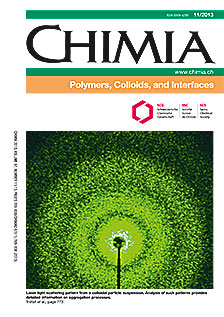Protein–Polymer Supramolecular Assemblies: A Key Combination for Multifunctionality
DOI:
https://doi.org/10.2533/chimia.2013.791Keywords:
Amphiphilic copolymers, Enzymes, Nanoreactors, Polymer membranes, ProteinsAbstract
2D/3D structures resulting from self-assembly of amphiphilic block copolymers can be combined with bioactive compounds, such as proteins and enzymes, to create supramolecular assemblies with specific desired properties and functionality. Chemical tuning of the architecture and properties of supramolecular assemblies to accommodate sensitive biomolecules allows the development of new soft hybrid materials that benefit from the robustness of polymers and from the functionality of biomolecules. The encapsulation/insertion of biomolecules (enzymes, mimics, proteins) in self-assembling block copolymer vesicles enables design of 'nanoreactors' both in solutions and at surfaces for highly diverse applications, ranging from production of antibiotics to creation of artificial organelles. When membrane proteins are inserted into polymer membranes, it is possible to generate functional membranes or active surfaces with a rapid and specific response. In addition, the selective binding of ligand-terminated polymers holds potential for targeted delivery of drugs, or for immobilization on solid support, to provide functional 3D assemblies on an extended surface.Downloads
Published
2013-11-27
Issue
Section
Scientific Articles
License
Copyright (c) 2013 Swiss Chemical Society

This work is licensed under a Creative Commons Attribution-NonCommercial 4.0 International License.
How to Cite
[1]
Chimia 2013, 67, 791, DOI: 10.2533/chimia.2013.791.







